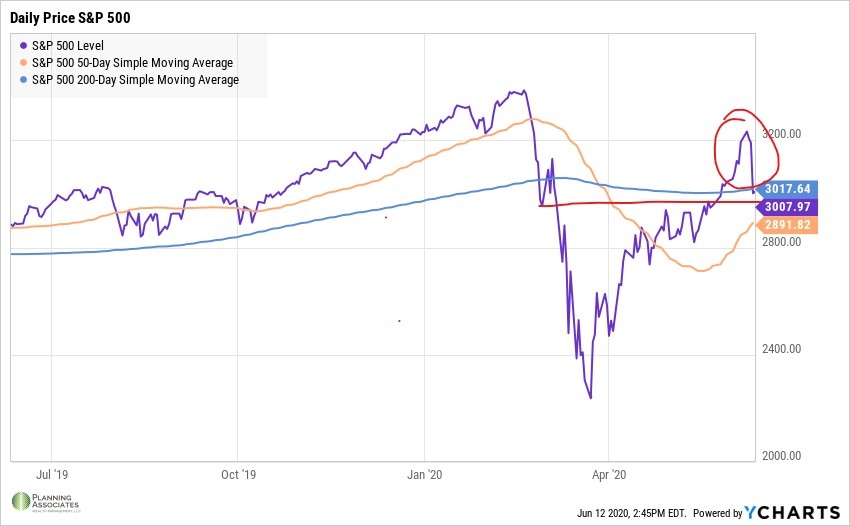By: Ralph C. Freibert III, Investment Advisor Representative
If there is one thing I have learned in my 30-plus years as a student and professional in investment management it is “investment returns are random”. Many interpret that statement the following way. Investment returns do not follow any logic or pattern, but that is not what random means in this context. It simply means that they cannot be predicted with any certainty over time.
In fact, investment returns often follow very predictable patterns of cause and effect. However, there are the things that cannot be accounted for and often surprise us all. A great example of this is the Coronavirus, its rapid spread, and the lasting impact upon our economy and society. If not for those darn unexpected events, the math of investment management would be quite simple. You know, Bill and Sally make $150,000 and invest 10% of their income in the equity (stock) markets each month, so we know how much money is flowing into the market on average. Or, XYZ company is earning $1.50 per share each quarter and the earnings are growing at a rate of 20% per year. I can do that type of math in just a few minutes. Unfortunately, that is not how a vast organism like the United States and world markets work. People and events are just not predictable that way.
The past few weeks have proven to be both predictable and unpredictable. Our investment management team meets twice each week to discuss our previous readings, review, and analysis. Last Friday, we discussed the rapid advancement of the market and the optimism reflected in stock prices. We had a couple laughs over some of the reasons this may be taking place, one of which was, “of course the market is going up, there is three trillion more dollars in the hands of Americans and American businesses that didn’t exist before.” However, the tone was a bit more somber this past Monday as we were seeing a technical pattern begin to emerge.
Technical patterns are those that develop by looking at various historical information of investments and investment markets’ price and volume. Below is one of the S&P 500 daily prices for the past twelve months.
I have circled the very rapid increase in the price of the index and the rapid decline yesterday. The pattern that had emerged was what looked like a “Short Squeeze” which could indicate a rapid decline in prices. If you are wondering, “what is a short squeeze,” we have to first define “short”, then we will explain the concept of a “squeeze”.

Short selling is an investment or trading strategy that speculates on the decline in a stock or other securities price. It is an advanced strategy that should only be undertaken by experienced traders and investors[1]. Here is how it works:
Jim believes that IBM is going to go down, based upon his personal analysis. Tommy owns IBM and has done so for the past 20 years. He likes the stock and the dividend it pays. Also, he bought it so long ago that he will pay significant taxes should he sell the stock. So, he is not likely selling anytime soon regardless of short-term price moves.
Jim knows that Tommy owns the stock and his position, so he calls Tommy and says, “Hey! I know you own IBM. I have been watching some things and think it is going to go down because… Can I borrow IBM? I’ll make sure you get all of the dividends paid while I have the stock and will pay you interest as well”
Tommy says, “I’m not going to sell the stock and if you think it is going down, sure I’ll take a little extra income for your efforts. What are you going to do with it?” To which Jim replies, “I’m going to sell it short. I am going to sell your stock in my account, but since I am selling it, you still technically have it in your portfolio, with my promise to replace it when needed.”
If the stock goes down as Jim expects, he can buy the stock back from Tommy at the lower price and Jim keeps the difference. Tommy simply gets his IBM back in his account. For Jim to make any money, IBM has to go down in price enough to cover any transactions cost associated with the buying and selling, any dividends that IBM pays while the stock is sold short, and any interest paid for the borrowing. Those costs can be five percent or more, so IBM has to go down a lot before Jim makes any money and the risk is very big.
Think of owning stock as an unlimited upside because the stock can theoretically keep rising in price as the company continues to grow, and his downside is limited to the money invested in IBM. If a share of IBM is $100, then the most Tommy can lose is $100. For Jim, his short sale is just the opposite. The most he can make is $100, because that is the most it can go down, but his potential loss is unlimited because he may have to buy back the stock at a much higher price, plus the dividends and interest.
Since the losses are unlimited, investors often place an order to buy automatically if the stock rises to a certain height at the same time the short the stock. This way, their potential loss is limited to the price set to buy, and this is where the fun begins in the market.
If the market is going up and an investor is short, he/she is losing money every day the stock is higher than where they sold it short and that loss is compounded by the dividends and interest. As the market continues its climb, the program trades begin to buy the stock automatically to stop the losses, which simply pushes the stock higher and higher. This rapid climb then gets the attention of average investors who say, “Wow! The market is really doing well. I should invest now.” And, bam! The shorts are closed through the automatic buying (there is only so much to cover) and with the absence of forced buying the market begins its decline with no support.
I was having a conversation with someone recently who felt this was likely a good time to buy because the market is down. But, it isn’t down as much as before and we still do not know how far it might fall if another wave of infections impact the economy, nor do we know how much damage has already been caused by the virus.
Therefore, we say, “Investment returns are random”. Sure, we can state with some confidence what we see taking place, but there is much more that we cannot see, like a microscopic virus. We cannot see it and it is spreading without our knowledge until after it is too late.
What we can predict with some certainty is we will likely find a vaccine for this virus in the next twelve to eighteen months, or we will improve our ability to treat it. We also know that we are finding ways to operate under a new normal. Sadly, the easiest prediction is if people are given money for nothing and time on their hands, and pushed into survival mode, anarchy is close behind.
We simply need to be patient and most importantly prudent in decision making. If you start feeling like you have a handle on the markets and feel it is a good time to buy, stop!! You may simply be one of those average investors I spoke of who gets caught in the “Short Squeeze”.
[1] Sourced from Investopedia.com; June 12, 2020
This commentary reflects the personal opinions, viewpoints and analyses of Planning Associates Wealth Management, LLC employees providing such comments, and should not be regarded as a description of advisory services provided by Planning Associates Wealth Management, LLC or performance returns of any Planning Associates Wealth Management, LLC client. The views reflected in the commentary are subject to change at any time without notice. Nothing in this commentary constitutes investment advice, performance data or any recommendation that any particular security, portfolio of securities, transaction or investment strategy is suitable for any specific person. Any mention of a particular security and related performance data is not a recommendation to buy or sell that security. Planning Associates Wealth Management, LLC manages its clients’ accounts using a variety of investment techniques and strategies, which are not necessarily discussed in the commentary. Investments in securities involve the risk of loss. Past performance is no guarantee of future results.

Recent Comments